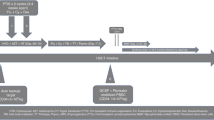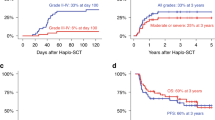Abstract
Autologous PBSC transplantation is a preferred treatment for patients with polyneuropathy, organomegaly, endocrinopathy, M protein, and skin changes (POEMS syndrome). However, data on stem cell mobilization in POEMS syndrome are limited. We retrospectively reviewed outcomes and factors prognostic of mobilization in newly diagnosed patients with POEMS syndrome. A total of 56 patients (41 men and 15 women) were included and the median age was 45 years (range, 24–62). All patients underwent mobilization with CY plus granulocyte CSF (G-CSF) (n=38) or G-CSF alone (n=18). The median total number of harvested CD34+ cells was 2.01 × 106/kg (range, 0.18–9.0 × 106/kg). In all, 29 (51.8%) patients failed to yield more than 2 × 106/kg CD34+ cells, and among them, 7 (12.5%) patients yielded <1 × 106/kg CD34+ cells. The overall mobilization-related morbidity was 23.3% and acute renal failure was the most common complication during mobilization. Multivariate analysis showed that hepatomegaly (odds ratio 0.06, 95% confidence interval (CI) 0.01–0.43) and mobilization regimen of G-CSF alone (odds ratio 0.08, 95% CI 0.01–0.70) were independent prognostic factors for successful mobilization in POEMS syndrome. In conclusion, mobilization in newly diagnosed patients with POEMS syndrome is challenging with low yield of CD34+ cells and high morbidity. Induction therapy before mobilization might improve the efficacy and safety of mobilization.
This is a preview of subscription content, access via your institution
Access options
Subscribe to this journal
Receive 12 print issues and online access
$259.00 per year
only $21.58 per issue
Buy this article
- Purchase on Springer Link
- Instant access to full article PDF
Prices may be subject to local taxes which are calculated during checkout
Similar content being viewed by others
References
Dispenzieri A . POEMS syndrome: 2011 update on diagnosis, risk-stratification, and management. Am J Hematol 2011; 86: 591–601.
Dispenzieri A . POEMS syndrome. Blood Rev 2007; 21: 285–299.
Li J, Zhang W, Li J, Duan MH, Guan HZ, Zhu WG et al. Combination of melphalan and dexamethasone for patients with newly diagnosed POEMS syndrome. Blood 2011; 117: 6445–6449.
Dispenzieri A, Moreno-Aspitia A, Suarez GA, Lacy MQ, Colon-Otero G, Tefferi A et al. Peripheral blood stem cell transplantation in 16 patients with POEMS syndrome, and a review of the literature. Blood 2004; 104: 3400–3407.
Kuwabara S, Misawa S, Kanai K, Suzuki Y, Kikkawa Y, Sawai S et al. Neurologic improvement after peripheral blood stem cell transplantation in POEMS syndrome. Neurology 2008; 71: 1691–1695.
Dispenzieri A, Lacy MQ, Hayman SR, Kumar SK, Buadi F, Dingli D et al. Peripheral blood stem cell transplant for POEMS syndrome is associated with high rates of engraftment syndrome. Eur J Haematol 2008; 80: 397–406.
Jaccard A, Royer B, Bordessoule D, Brouet JC, Fermand JP . High-dose therapy and autologous blood stem cell transplantation in POEMS syndrome. Blood 2002; 99: 3057–3059.
Shimizu N, Nakaseko C, Sakaida E, Ohwada C, Takeuchi M, Kawaguchi T et al. Factors associated with the efficiency of PBSC collection in POEMS syndrome patients undergoing autologous PBSC transplantation. Bone Marrow Transplantation 2012; 47: 1010–1012.
Dispenzieri A, Kyle RA, Lacy MQ, Rajkumar SV, Therneau TM, Larson DR et al. POEMS syndrome: definitions and long-term outcome. Blood 2003; 101: 2496–2506.
Graham RC, Hughes R . A modified peripheral neuropathy scale: the overall neuropathy limitations scale. J Neurol Neurosurg Psychiatry 2006; 77: 973–976.
Hashiguchi T, Arimura K, Matsumuro K, Otsuka R, Watanabe O, Jonosono M et al. Highly concentrated vascular endothelial growth factor in platelets in Crow–Fukase syndrome. Muscle Nerve 2000; 23: 1051–1056.
Watanabe O, Arimura K, Kitajima I, Osame M, Maruyama I . Greatly raised vascular endothelial growth factor (VEGF) in POEMS syndrome. Lancet 1996; 347: 702.
D’Souza A, Hayman SR, Buadi F, Mauermann M, Lacy MQ, Gertz MA et al. The utility of plasma vascular endothelial growth factor levels in the diagnosis and follow-up of patients with POEMS syndrome. Blood 2011; 118: 4663–4665.
Akard L . Optimum methods to mobilize stem cells. J Clin Oncol 2000; 18: 3063.
Narayanasami U, Kanteti R, Morelli J, Klekar A, Al-Olama A, Keating C et al. Randomized trial of filgrastim versus chemotherapy and filgrastim mobilization of hematopoietic progenitor cells for rescue in autologous transplantation. Blood 2001; 98: 2059–2064.
de Azevedo AM, Goldberg Tabak D . Life-threatening capillary leak syndrome after G-CSF mobilization and collection of peripheral blood progenitor cells for allogeneic transplantation. Bone Marrow Transplant 2001; 28: 311–312.
Nakagawa N, Ota H, Tanabe Y, Kabara M, Matsuki M, Chinda J et al. A case of idiopathic systemic capillary leak syndrome with high serum levels of G-CSF on exacerbation. Intern Med 2011; 50: 597–600.
Jimenez-Zepeda VH, Trudel S, Reece DE, Chen C, Rabea AM, Kukreti V . Cyclophosphamide and prednisone induction followed by cyclophosphamide mobilizaion effectively decreases the incidence of engrafment syndrome in patients with POEMS syndrome who undergo stem cell transplantation. Am J Hematol 2011; 86: 873–875.
Madan S, Kumar SK, Dispenzieri A, Lacy MQ, Hayman SR, Buadi FK et al. High-dose melphalan and peripheral blood stem cell transplantation for light-chain amyloidosis with cardiac involvement. Blood 2012; 119: 1117–1122.
Acknowledgements
This work was supported by a grant from Capital Research Fund on Clinical Application (Z111107058811019)
Author contributions: JL, WZ and DBZ designed the study, analyzed the data and wrote the paper. MHD, LJ, TNZ and BH contributed to the collection of data. LZ and JG contributed to mobilization and harvest of stem cell.
Author information
Authors and Affiliations
Corresponding author
Ethics declarations
Competing interests
The authors declare no conflict of interest.
Rights and permissions
About this article
Cite this article
Li, J., Zhang, W., Duan, MH. et al. PBSC mobilization in newly diagnosed patients with POEMS syndrome: outcomes and prognostic factors. Bone Marrow Transplant 48, 233–237 (2013). https://doi.org/10.1038/bmt.2012.138
Received:
Revised:
Accepted:
Published:
Issue Date:
DOI: https://doi.org/10.1038/bmt.2012.138
Keywords
This article is cited by
-
Prognostic study for overall survival in patients with newly diagnosed POEMS syndrome
Leukemia (2017)
-
Durable responses with autologous hematopoietic SCT in patients with POEMS syndrome
Bone Marrow Transplantation (2014)



